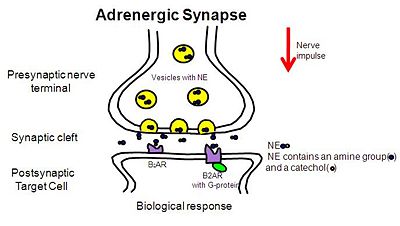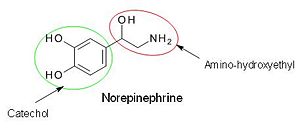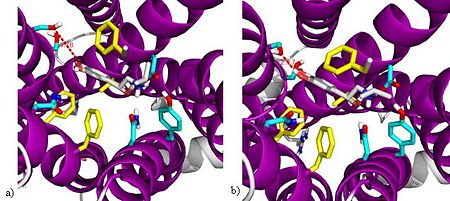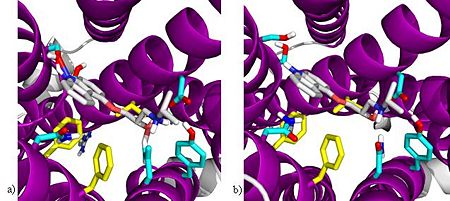Sandbox 121
From Proteopedia
Contents |
Modeling of Beta-2 Adrenergic Receptor: Ligand Binding and Activation
Students: Mary Acheampong, Kavita Bhikhi, Daviana Dueno, Bobby Glover, Lachoy Harris, Alafia Henry, Randol Mata, and Marisa Vanbrakle, Hostos-Lincoln Academy of Science
Teacher: Allison Granberry, Hostos-Lincoln Academy of Science
Mentors: Thijs Beuming, Schrodinger, Haregewein Assefa,Touro College of Pharmacy
Introduction
The Beta-2 Adrenergic Receptor (B₂AR) is a G-protein coupled receptor (GPCR) which, when stimulated by a catecholamine, causes the relaxation of various smooth muscles, and the production of glucose by glycogenolysis and gluconeogenesis. Pharmaceuticals acting through B2AR are important for treating asthma, chronic obstructive pulmonary disease (COPD), and premature labor. The structure of B2AR consists of 7-transmembrane domains, connected by three extracellular loops and three intracellular loops. At the base of the extracellular loops, buried within the transmembrane helices, there is a predominately hydrophobic binding pocket with several crucial polar residues that interact with ligands. Interestingly, certain polar interactions appear to play a role in the conversion of the receptor from an active to an inactive state. Recent crystallography of B2AR has revealed that the active state, relative to the inactive state, shows only minor changes in the binding pocket, whereas critical shifts occur at the cytoplasmic face. These conformational changes lead to a dissociation of the G-protein from the receptor, which then initiates a signaling cascade. The Hostos-Lincoln Academy SMART team (Students Modeling A Research Topic) modeled ligands in complex with B2AR using 3D printing technology. Supported by grants from the HHMI Precollege Program and the Camille and Henry Dreyfus Foundation.
Background Information
NE binds to adrenergic receptors embedded in the postsynaptic effector cell membrane. Following binding of NE, to either alpha or beta receptors, conformational changes in the receptor lead to a disassociation of the G protein from the cytoplasmic face of the receptor which activates a second messenger, initiating a signaling cascade.
|
Structure of Beta 2 Adrenergic Receptor
B2AR is a single chain that crosses the lipid membrane 7 times from the extracellular to cytoplasmic surface. There are 3 extracellular loops and 3 intracellular loops. The is located to the center of the extracellular surface.
When B2AR is activated, the G-protein disassociates. A surrogate nanobody, , that is a camelid antibody produced to mimic the G-protein needed for an active state of the B2AR.
Active B₂AR in complex with BI-167107: and Interactions
Ligands
To understand activation of β₂AR by various ligands, it is first essential to define the term baseline activity. In the absence of a ligand within the binding pocket, there is some basal activity between the receptor and its signaling pathway. This activity is not considered an active state of the receptor but simply the baseline activity of the receptor. There are two extremes to the activity of the receptor that can be seen with binding of either an inverse agonist or an agonist. The inverse agonist reduces the activity to the level below that of the basal activity of the receptor whereas the agonist activates the receptor to its maximum. A ligand that is an antagonist actually has no effect on the basal activity of the receptor. An antagonist simply sterically blocks the receptor so that no other ligand can bind. Their activity would be considered baseline. Antagonists for the adrenergic receptors are commonly called Beta Blockers. Although Beta Blockers are not prescribed for for their β₂AR blocking activity, they are frequently prescribed for their action on the Beta-1 Adrenergic Receptors in people with cardiovascular disorders such as hypertension and angina. A number of selective β₂AR agonists are used for the treatment of asthma and chronic obstructive pulmonary disease (COPD).
| Name | Description | Chemical Structure | Photo |
|---|---|---|---|
| Isoproterenol | Isoproterenol is an agonist that is structurally similar to NE and readily binds to β₂AR with high affinity. Isoproterenol contains an isopropyl amino group and a catechol group. | ||
| BI-167107 | The active state of β₂AR was crystallized using BI-1671071 . Although it is not a catecholamine, it is a full agonist. | ||
| Carazolol | Carazolol is an inverse agonist designed to inhibit β₂AR. Carazolol contains a propylamino and a carbazole group. |
Comparison of the Inverse Agonist and the Agonist
Notable differences between carazolol and both isoproterenol and the natural agonist norepinephrine are that: (i) Carazolol lacks the hydroxyl groups thought to be necessary for the activation of β₂AR. (ii)The side chain of carazolol is two atoms (one carbon and one oxygen) longer in length from the amino group to the carbazole moiety. These are common characteristics of β₂AR antagonists.
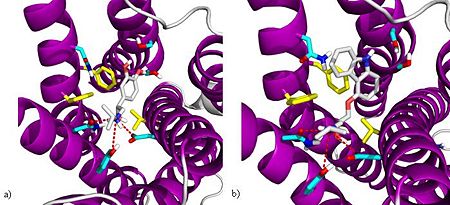
Ligand Binding
Ligands share several key interactions in the binding pocket including:
(i)Polar interactions between:
The amine and Asp113 in TM3, Asn312 in TM7, and Tyr316 in TM7.
Hydroxyls and other h-bond donors and Ser207 in TM5, Ser203 in TM5, and Asn293 in TM6.
(ii) Hydrophobic interaction between ligand and Val117 in TM3, Phe193 in ECL2, Phe289 in TM6, and Phe290 inTM6.
Conformational Change
|
When an agonist is in the a 2.1Å inward movement of TM5 at Ser207 is observed. This bulge at ser207 allows for a hydrogen bond between the ligand and the receptor. This interaction appears to be a key event in activation.
After the agonist binds, there is a rearrangement of interactions between residues located beneath the binding pocket that contributes to a rotation and outward movement of TM6 at Phe282. This change is associated with the breaking of the ionic lock between Glu268 in TM6 and Arg131 in TM3, resulting in an 11.4Å outward movement of the helix at the cytoplasmic face.
Molecular Morph
The coordinates for molecular morphs between inactive state of B2AR (2rh1) and active state (3p0g) were generated using iPyMOL and eMovie (http://www.weizmann.ac.il/ISPC/eMovie.html). Morphs, a series of 10 linear interpolations between a starting and finishing model, are useful when viewing the transition of a conformational change. This model of B2AR using morphs should not be thought of as precise animation of conformational changes upon activation but rather as a comparison of the inactive state to the active state.
Reference
1. Vadim Cherezov, Daniel M. Rosenbaum, Michael A. Hanson, Søren G. F. Rasmussen, Foon Sun Thian, Tong Sun Kobilka, Hee-Jung Choi, Peter Kuhn, William I. Weis, Brian K. Kobilka, Raymond C. Stevens (2007). High Resolution Crystal Structure of an Engineered Human B2-Adrenergic G Protein- Coupled Receptor Science 318, 1258-1265.
2.Søren G. F. Rasmussen, Hee-Jung Choi, Juan Jose Fung, Els Pardon, Paola Casarosa, Pil Seok Chae, Brian T. DeVree, Daniel M. Rosenbaum, Foon Sun Thian, Tong Sun Kobilka, Andreas Schnapp, Ingo Konetzki, Roger K. Sunahara,Samuel H. Gellman, Alexander Pautsch, Jan Steyaert, William I. Weis & Brian K. Kobilka (2011). Structure of a nanobody-stabilized active state of the B2 adrenoceptor Nature 469, 175-180.
Acknowledgements
Camille and Henry Dreyfus Foundation, The Rockefeller University Center for Clinical and Translational Science, The Rockefeller University Science Outreach Program, Howard Hughes Medical Institute Pre-college Program, Center for BioMolecular Modeling, Milwaukee School of Engineering, The David A. Cofrin Center for Biomedical Information, in the HRH Prince Alwaleed Bin Talal Bin Abdulaziz Alsaud Institute for Computational Biomedicine, Weill Cornell Medical College,
